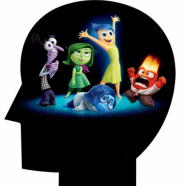 July
02
July
02
Tags
Turning the Brain ‘Inside Out’
Who would’ve thought that a film that takes place inside the mind of an 11-year-old girl named Riley and uses her personified emotions as the main protagonists would break the box office record for original movies and be such a worldwide sensation? From the moment I first heard about Inside Out, my own little Joy was dancing around my head with glee (my favorite animation studio making a movie that takes place inside the brain?!), but Skepticism tried to keep Joy at bay. Would even the storytelling masters at Pixar be able to make the brain seem as exciting to kids as it is to us here at NeuWrite? How much scientific integrity would they have to sacrifice to make it accessible? And how would they visualize something as immensely complicated as an 11-year-old’s brain?
Joy isn’t dancing around in my head because they accurately portrayed all of the brain’s technical nuances. There isn’t a neuron in sight, and yet, in classic Pixar fashion, there are countless details that prove the filmmakers did their homework. Their portrayal of the interplay between emotions, of memory consolidation, and the changes that children’s brains undergo during adolescence is not only beautifully done and incredibly moving, but also accurately depicts much of our current understanding of the emotional brain.
The Characters of Inside Out: Joy, Sadness, Disgust, Anger, and Fear
The main protagonists of Inside Out aren’t princesses, superheroes, or even humans; they are personified versions of the some of our most fundamental emotions. What exactly are the fundamental emotions has been a fascinating and much debated question for well over a century. In fact, it was Sir Charles Darwin himself who made perhaps the first major advance in the scientific study of emotions when he published The Expressions of Emotions in Man and Animals in 1872 [1]. By comparing emotional facial expressions in humans and animals, he proposed a number of fundamental, universal emotions, including the five in Inside Out.
A century later, American psychologist Paul Ekman advanced Darwin’s theory by surveying people from diverse cultures across the globe and found that the expressions of happy, sad, disgusted, angry, fearful and surprised emotions were universal. It’s no coincidence that five of these six emotions are those featured in Inside Out; in fact, the filmmakers were regularly consulted by Ekman himself and Berkeley psychologist Dacher Keltner in order to get the emotions right. And if you are wondering what happened to Surprise, Director Pete Docter said that since he imagined drawing it similarly to Fear, they decided to blend some Surprise into the character of Fear instead of making two separate characters.
Of course, our emotions aren’t actually little critters jumping around inside our brains, so what DO they look like? In reality, each emotion is a complex interplay between cells, brain regions, hormones, genes, and much more. A prominent view has been that emotion is controlled primarily by the limbic system, but the more we learn about emotions, the less we are able to subdivide the brain into the strictly “hot” emotional regions and the “cold” thinking regions [2]. A more modern depiction of the “emotional brain” is depicted below and includes traditional limbic areas such as the amygdala and hypothalamus but also strongly involves regions like the prefrontal and cingulate cortices [1].
By far the best understood neural circuitry of a primary emotion is the role of the amygdala in fear. Much of this knowledge has come from studies of fear conditioning in rodents, in which rodents learn to fear a previously innocuous stimulus, such as a tone, after that stimulus is repeatedly paired with a naturally fear-inducing stimulus, like a foot shock. These studies have reliably demonstrated that there is considerably more activity in the amygdala when the rodent is afraid than when it is not, and damage to the amygdala interferes with the animal learning to be afraid [2]. The same seems to be true in humans; for instance, there have been many case studies of people with damage to the amygdala who similarly fail to become fear-conditioned [1].
Although the other emotions featured in Inside Out are less well understood – primarily because there is not yet a strong behavioral model of these emotions in animals that would allow neuroscientists to examine their underlying neural circuitry in detail – some studies in human neuroimaging (measuring changes in brain activity) and neuropsychology (studies of patients with brain damage) hint at which brain areas could be emotional “hubs”. With regards to Joy, “hedonic hotspots” have been identified in the nucleus accumbens and ventral pallidum (see above) that elicit sensory pleasure when stimulated [3]. However, a major challenge in understanding the neural basis of Joy and the other primary emotions in Inside Out is that they are incredibly complex and multidimensional. For instance, “joy” could refer to the emotion you feel while eating a delicious meal, during a social interaction, after accomplishing a major goal, etc. Some argue that the orbitofrontal cortex (which receives input from the hedonic hotspots and many other areas) could be responsible for generating the feelings we associate with Joy in a variety of contexts [4], but how much these diverse manifestations of “joy” actually have in common inside the brain is not fully clear.
One of the most striking things about the film is the unlikely heroine pair of Joy with Sadness. Interestingly, in initial versions of the film, it was Fear, not Sadness, who accompanied Joy on her journey across Riley’s mind. But when it wasn’t working, and after receiving consultation from psychologist Dacher Keltner about the psychological role of sadness as an important catalyst for Joy-seeking behaviors [5], the filmmakers changed their approach. From a neuroscience perspective, this pairing makes more sense as well. Whereas animal studies have identified a pretty reliable neural circuit for fear, happiness and sadness seem to be especially diffuse across the brain. For instance, a survey of many neuroimaging studies of sadness revealed that over 70 different brain areas were implicated in the experience of this emotion [6], many of which have also been implicated in happiness. Thus, it seems likely that there is a close interplay between happiness and sadness inside the brain as is depicted in the film.
Inside Riley’s head: A glimpse into Memory
After meeting the voices in Riley’s head, we get to take a tour of her mind. As visually stunning as it is, the Disneyland-esque layout should certainly not be taken as a literal representation of her brain. Core aspects of our personalities are not kept in specific “islands” of our mind; all emotions don’t necessarily operate equally out of a single “Headquarters”; and our subconscious is certainly not a huge pit physically beneath our consciousness. However, where the film is most remarkably accurate is in its portrayal of memories.

Joy gazes in wonder at Long-Term Memory
In Inside Out, Riley’s memories are little orbs that are colored according to a particular emotion. They emerge continuously throughout the day, but at night when Riley falls asleep, they get shot up into a chute and sent out of Headquarters and into “Long-term Memory”. Although in reality our memories are changes in how neurons communicate with each other rather than glowing bowling balls, the general principles of memory portrayed in the film are remarkably accurate. First, it is noteworthy that Riley’s memories get sent to Long-Term Memory specifically when she’s sleeping, since sleep is known to promote memory consolidation, which is the storage of long-term memories in the cortex (surface) of the brain [7]. The role of the emotions in helping create Riley’s memories is also rooted in neuroscientific truth. As has already been discussed in a previous movie-themed NeuWrite post, the amygdala (important for emotions in general, not only fear) communicates extensively with the hippocampus, which is the region of the brain that is critical for forming new memories and consolidating them into long-term memory. Thus, the amygdala appears to be especially important for memory encoding (creating the memories in the first place) and retrieval (remembering).
The portrayal of how Riley remembers things from her early childhood is particularly intriguing. The modern view of long-term memory is that the hippocampus coordinates with distributed regions throughout the brain’s cortex to “store” memories. When we recall a memory, the hippocampus reactivates those cortical regions, just like when Riley’s memory orbs get sent back through the chute from Long-Term Memory to Headquarters whenever she remembers something [8]. However, over time, memories become less dependent on the hippocampus in order to be remembered. Instead, the prefrontal cortex takes a more active role and coordinates the activity of the parts of the cortex where the memory resides without help from the hippocampus [9; see below schematic]. The Headquarters in Inside Out is perhaps analogous to the prefrontal cortex, since that is where the emotions decide which remote memories from Riley’s past she should remember. Clearly, there are many examples of how the film beautifully captures many important and sophisticated aspects of memory.
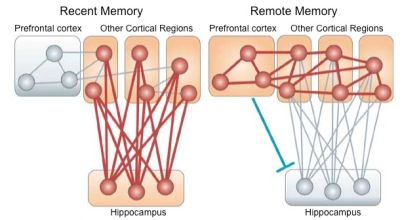
Schematic of long-term memory organization. Whereas the hippocampus is important for reactivating areas of cortex when recalling a recent memory, over time, the prefrontal cortex directly reactivates those areas of cortex without the hippocampus.
Riley’s Changing Brain
Pete Docter (director of multiple other Pixar masterpieces including Monster’s Inc. and Up) was inspired to create Inside Out by watching his own daughter grow up. By age 11, “She used to have this happy, goofy spirit. But she began to move toward being more quiet and more reclusive” [10]. And so, with this film, he decided to tackle the questions that he was forced to wrestle with while watching his daughter approach adolescence: what on earth was she thinking? And what was going on inside her head to make her change in these ways?
This is, in my opinion, the most powerful aspect of the film and the point where Docter’s abstract portrayal of the brain was most profound. After being uprooted from her Minnesota home and moving to San Francisco, Riley’s emotions begin to run amuck…literally. Joy and Sadness accidentally get thrown out of Headquarters, and with Disgust, Anger and Fear running the show, Riley starts to act moody, irritable, and irrational.
In reality, instead of Riley’s behavioral and emotional changes being caused by her emotions moving in and out of Headquarters, the real culprit is likely structural and functional changes that are taking place in some of the emotional hubs of her brain and altering how they communicate with each other. In the prefrontal cortex, the volume of prefrontal gray matter (where neurons’ cell bodies reside) and the density of synapses (points of communication between neurons) peaks in early adolescence and then gradually declines during the rest of adolescence through early adulthood [11]. Meanwhile, adolescents experience heightened amygdala activity (remember the amygdala’s role in fear and other emotions?) in response to emotional cues relative to both children and adults, which could be related to adolescent’s heightened emotional reactivity [12]. Imbalanced communication between the amygdala and prefrontal cortex, which have been shown to have a sort of push-pull relationship in emotion-related tasks such as fear conditioning, has also been observed in adolescents. These observations have led to the hypothesis that the adolescent brain – and emotion – is particularly volatile because of an imbalance between maturing subcortical regions (including the amygdala) and the prefrontal cortex which is gradually changing but still immature [12].
At the end of the film when we see Riley getting through her emotional turmoil, we also see all sorts of changes inside her head. Instead of fighting for the control board in Headquarters, all five emotions are sitting and working together. The “islands” of Riley’s personality are bigger, more sophisticated, and greater in number. And most strikingly, Riley’s memory orbs become marbleized, reflecting fusions of multiple emotions rather than being strictly happy or sad. I was struck by this beautiful visualization of what neuroscientists and psychologists understand – and also what remains to be discovered – about how the brain’s many connections are being refined and enriched during this critical period of development.
Overall, Inside Out is a visually stunning and poignant film set in front of an ambitious backdrop: a kid-friendly abstraction of the human brain. Without a trace of even a single neuron, Pete Docter and his fellow Pixar filmmakers managed to make a film that gets kids thinking about how their brains work. And that’s got Joy doing a victory dance inside my own head.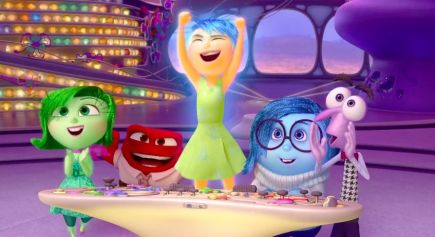
References:
[1] Dalgleish, T. (2004). The emotional brain. Nature Reviews Neuroscience, 5, 582-589.
[2] LeDoux, J.E. (1995). Emotion: clues from the brain. Annual Review of Psychology, 46, 209-235.
[3] Kringelbach, M.L., & Berridge K.C. (Eds.). (2010). Pleasures of the Brain. New York, NY: Oxford University Press.
[4] Kringelbach, M.L., & Berridge, K.C. (2012). The Joyful Mind. Scientific American, 307(2), 40-45.
[5] Anwar, Y. (2015, June 20). How ‘Inside Out’ nailed the science of kids’ emotions. The Huffington Post. Retrieved from http://www.huffingtonpost.com/2015/06/20/inside-out-psychology_n_7628000.html.
[6] Freed, P.J., & Mann, J.J. (2007). Sadness and loss: Toward a neurobiopsychosocial model. American Journal of Psychiatry, 164(1), 28-34.
[7] Diekelman, S., & Born, J. (2010). The memory function of sleep. Nature Reviews Neuroscience, 11, 114-126.
[8] Squire, L.R., & Wixted, J.T. (2011). The cognitive neuroscience of human memory since H.M. Annual Review of Neuroscience, 34, 259-288.
[9] Frankland, P.W., & Bontempi, B. (2005). The organization of recent and remote memories. Nature Reviews Neuroscience, 6, 119-130.
[10] Cavna, M. (2015, June 19). ‘Inside Out’ explores angst of adolescence. The Washington Post. Retrieved from http://www.pressreader.com/usa/the-washington-post1047/20150619/282651801123330/TextView.
[11] Blakemore, S-J., & Robbins, T.W. (2012). Decision-making in the adolescent brain. Nature Neuroscience, 15(9), 1184-1191.
[12] Casey, B.J., et al. (2010). The storm and stress of adolescence: insights from human imaging and mouse genetics. Developmental Psychobiology, doi: 10.1002/dev.20447.
Images:
Featured image: http://www.ramascreen.com/wp-content/uploads/2014/11/Pixars-Inside-Out-movie-poster-407×586.jpg
Ekman’s emotions: http://www.happinessworks.com/assets/images/six-actors.jpg
Inside Out‘s emotions: http://www.comebackmomma.com/wp-content/uploads/2015/06/1808.jpg
Emotional brain: [1]
Joy with long-term memory: http://i.ytimg.com/vi/P-PFrvVvccM/maxresdefault.jpg
Long-term memory schematic: [9]
Inside Out: http://images-cdn.moviepilot.com/image/upload/c_fill,h_462,w_847/t_mp_quality/screen-shot-2015-03-10-at-2-35-38-pm-inside-out-trailer-breakdown-is-that-a-toy-story-easter-egg-png-296970.jpg

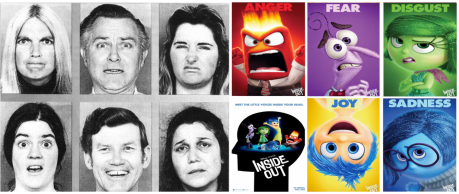
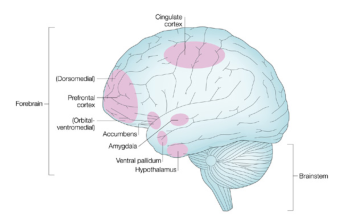
I just saw this last night, thought I’d add a few thoughts.
Clearly, narrative is king at Pixar and this wasn’t intended to be a documentary on brain function. So it was very exciting to see how effortlessly the writers and animators incorporated (more-or-less) accurate depictions of various features of neuroscience.
As observed above and elsewhere, they clearly did most of their homework into the processing of memory (one imagines the manual that Joy reads from at one point is inspired by some of their own research). Perhaps it was my own bias, but I thought I saw in the Headquarters machinery where memories are first formed the structure of the hippocampus: the curvatures of the apparatus reminded me of the dentate gyrus, CA3, CA1, etc, and seemed to show the memory balls accurately rolling from one area to the next. I was also struck by their representation of cortex as rows upon rows of shelves full of memories. When viewed from above, the maze-like pattern seems clearly intended to evoke the wrinkled appearance of the cortex’s gyri and sulci. One missed detail here: the stacks of memories should have had six layers! (They had two). I also loved the double-helix sliding ladders (in cortex) and railings (in Headquarters).
Of course, some of the areas that Joy and Sadness explore are not really directly analogous to regions of the brain. Or at least I can’t think of any brain representation of “personality islands”, “abstract thought”, “imagination”, etc. Some of these might be based in psychology or cognitive science (the lines linking personality islands to Headquarters reminded me of the box-and-lines models that cogsci papers like to create), or might just be included for their accessibility (“the subconscious”). I wouldn’t be surprised if some scientists are critical of the movie for mixing the hard science with the more hypothetical (can audiences tell the difference?) but I also can’t fault a movie for wanting to tell a story.
There were a few missed opportunities as well. Dream production was depicted as a scripted TV show based on a collection of memories from the day. More apt would have been an improv performance: the producers are handed a single memory orb and begin to put on a show; halfway through they are suddenly handed another memory orb and must scramble to incorporate it into the ongoing narrative. When it comes to the memory orbs themselves, I wish they had portrayed the critical idea that the recall of memories alters them. While the movie does show that memories can be tinged with different emotions over time, it otherwise suggests that memories are more-or-less fixed recordings (Joy interacts with memory orbs like one would a video on your smartphone, rewinding them with a swipe to the left).
Reflecting on the movie, I wonder which of its ideas will stick with lay audiences and children the most. Will this movie change how people think about how they think? Most striking to me is the premise of the movie itself: a committee of our emotions are in control. Emotions are not passive experiences here. And what a wonderfully sly rejection of the entire reason-emotion dichotomy when it comes to decision-making! I particularly loved how the nature of the emotional committee directly contrasts with other common ways we might think of ourselves, for instance as a singular humunculus integrating information and so forth.
I hope that somewhere out there are now a lot of eleven year old proto-philosophers grappling with what’s going on in their heads: Am I I? Or are we We?
Pingback: A metaphorical tour of the brain | NeuWrite San Diego